Kasbah of the Udayas in Morocco: Step Into Rabat’s Oldest Fortress by the Sea where History, Art and Coastal Charm Meets.
I’ve visited the Kasbah of the Udayas in Rabat many times to enjoy the historic fortress, the Old blue and white streets and markets and the beautiful Andalusian gardens. It’s prominent fortress walls protecting the old town area of Rabat and Old section beckons to an older time when the fortress protected the city from local pirates and marauders from attacking the city. The remnants of the Kasbah has been scrubbed clean and is a beautiful historic landmark to enjoy and the more lived in areas of the blue and white streets mimics the more famous blue city of Chefchaouen but on a smaller scale.
Perched high above the Bou Regreg River, the Moroccan architectural style is impressive with the grand Bab Oaudaia Gate that protects everything inside the Kasbah. The more wider and scrubbed white washed sections of the Kasbah is more tourist focused but the more neighborhood like blue and white streets are composed of narrow winding alleyways with market stalls dotted around and catering more to a local crowd but still filled with aromas and visuals of a well lived in area next to the river and beach area. The blue and white symbolizes the Kasbahs relationship with the surroundings of beach, sky and sea.
I love to explore historic sites and the Kasbah of the Udayas is fun to explore every corner that promises surprises at every corner.
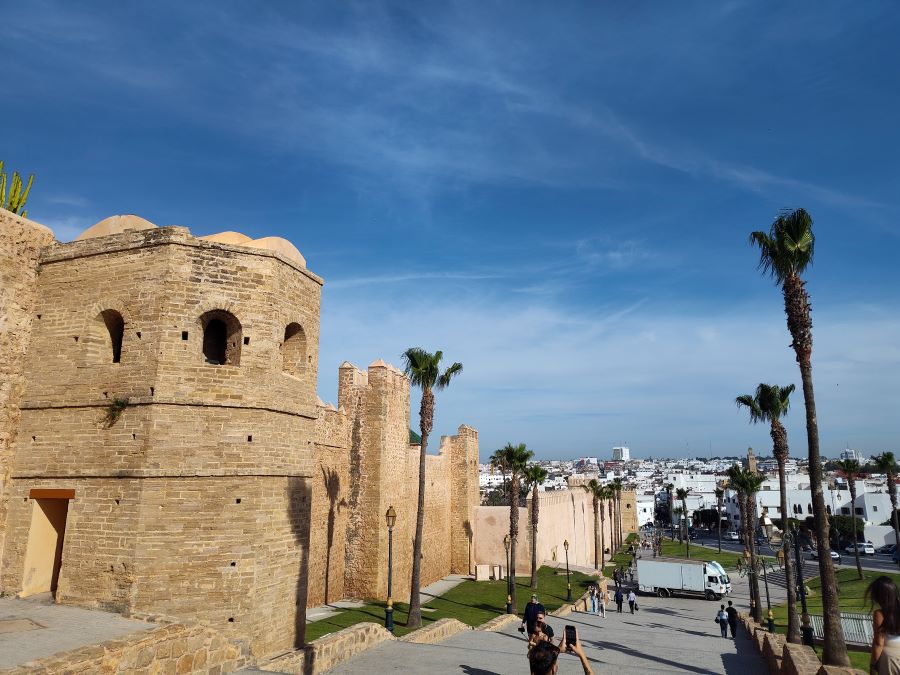
A brief history of Kasbah of the Udayas
The Kasbah of the Udayas, located at the mouth of the Bou Regreg River in Rabat, Morocco, has a long and layered history dating back to the 12th century. It was originally built by the Almohad dynasty as a military fortress to defend against invasions and control maritime traffic. Over the centuries, it has served various roles—home to Andalusian refugees expelled from Spain, a base for pirates during the 17th century, and later a neighborhood under the Alaouite dynasty. Its blend of Andalusian and Moroccan architecture, narrow streets, and ocean views make it a striking part of Rabat’s historic fabric and a UNESCO World Heritage site today.
Where is Rabat’s Kasbah located
Rabat’s Kasbah of the Udayas is perched on a cliff at the mouth of the Bou Regreg River, where it meets the Atlantic Ocean. It sits on the northern edge of Morocco’s capital city, offering sweeping views of the river, the nearby city of Salé, and the open sea. The kasbah is easily accessible from the heart of Rabat and is close to other key landmarks like the medina and the Andalusian Gardens. Its location made it a strategic military point historically, but today it draws visitors for its peaceful setting, historic charm, and scenic outlooks.
10 Main Attractions and Sites of the Kasbah of the Udayas (Rabat)
You can spend a few hours or even the whole day visiting all the attractions, markets and even beach areas around the Kasbah of the Udayas. This fascinating ancient fortress, palace and even blue and white city exudes the ancient city walls and still present lifestyle that exists today, making it a unique experience visiting this heritage site.
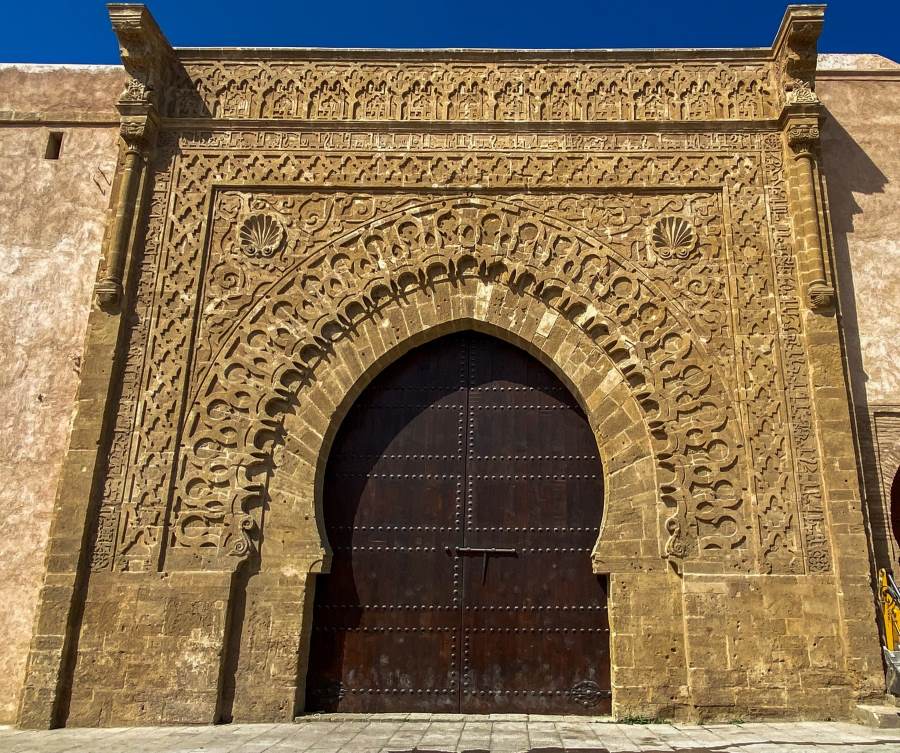
1. Bab Oudaia (Main Gate)
Bab Oudaia is the grand entrance to the Kasbah of the Udayas in Rabat and one of the city’s standout architectural landmarks. Built in the 12th century during the Almohad dynasty, the gate features intricate carvings, symmetrical horseshoe arches, and detailed stonework that reflect a blend of Islamic and Andalusian styles. Despite its imposing size and function as a military fortification, the craftsmanship of the gate gives it a refined, almost ceremonial appearance. The decorative motifs include geometric patterns and calligraphy that have withstood centuries of exposure. It stands as both a defensive structure and a symbol of Rabat’s layered history, welcoming visitors into the quiet, white-and-blue lanes of the kasbah beyond.
- Monumental Almohad-era gate built in the 12th century
- Intricate stonework with Andalusian and Moorish influence
- One of the most photographed architectural sites in Rabat
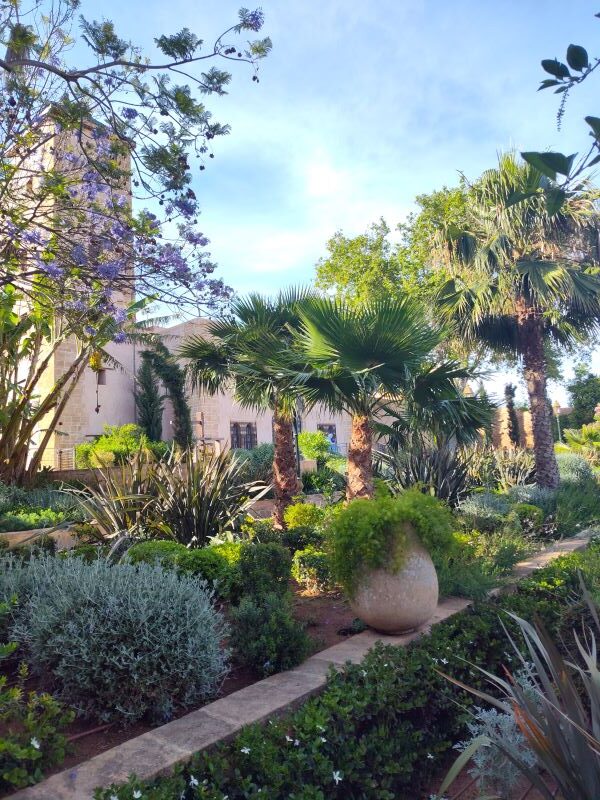
2. Andalusian Gardens
The Andalusian Gardens within the Kasbah of the Udayas offer a peaceful contrast to the surrounding fortifications, with neatly landscaped paths, citrus trees, and bursts of colorful flowers. Created during the French colonial period in the early 20th century, the gardens were designed in a traditional Andalusian style, blending Moorish influence with European symmetry. It’s a serene spot where locals and visitors alike come to relax under the shade of palms and orange trees, surrounded by the sounds of birds and distant ocean breeze. Stone benches and tiled walkways lead to quiet corners perfect for a break from the city, while the garden’s layout and charm make it one of the kasbah’s most inviting public spaces.
- Peaceful walled garden built during the French protectorate
- Features citrus trees, flowering plants, and shaded paths
- A relaxing spot with views of the kasbah’s architecture
Here’s a walking tour of the beautiful Andalusian Gardens in the Udayas Kasbah below
3. Kasbah Mosque (Jama’ al-Atiq)
The Kasbah Mosque, also known as Jama’ al-Atiq, is the main place of worship within the Kasbah of the Udayas and one of the oldest mosques in Rabat. Built in the 12th century during the Almohad period, the mosque has a modest, understated presence that blends seamlessly with the surrounding neighborhood. Its whitewashed exterior and simple square minaret reflect the minimalist style of Almohad architecture, focusing on proportion and form rather than ornate detail. Though not open to non-Muslim visitors, the mosque remains an active part of daily life in the kasbah, serving the small resident community. Its quiet dignity and historical importance make it a meaningful stop for those exploring the spiritual and architectural roots of Rabat.
- One of the oldest mosques in Rabat, dating back to the Almohad period
- Simple design with whitewashed walls and a square minaret
- Still an active place of worship
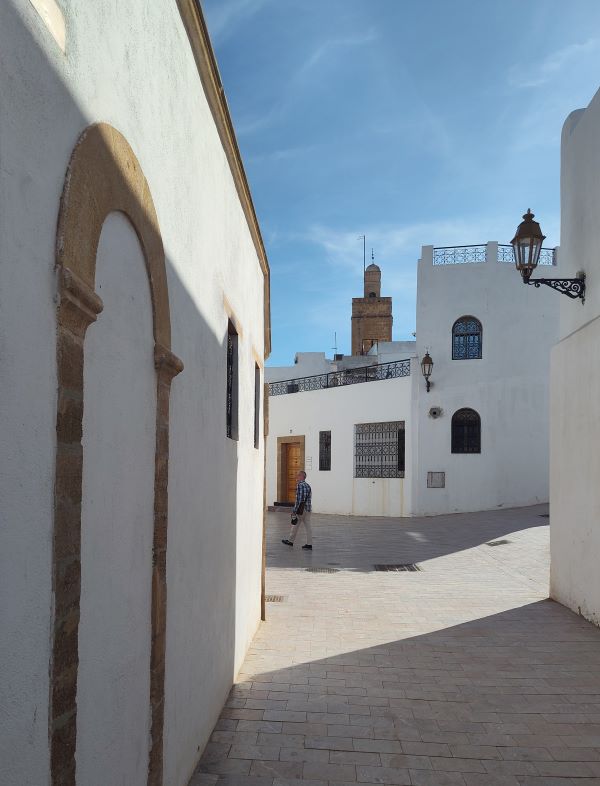
4. Rue Jamaa (Main Street Inside the Kasbah)
Rue Jamaa is the main street running through the heart of the Kasbah of the Udayas, and it offers a quiet, lived-in charm that feels worlds away from the bustle of central Rabat. Lined with whitewashed houses trimmed in varying shades of blue, the street reflects Andalusian influence and a coastal aesthetic that suits the kasbah’s clifftop setting. The narrow, winding path is mostly pedestrian, encouraging a slow pace and inviting you to notice the details—flower pots, carved wooden doors, ironwork windows, and occasional glimpses into private courtyards. Locals go about their routines while visitors wander, cameras in hand, drawn to the street’s simplicity and character. Rue Jamaa isn’t touristy, but that’s part of its appeal—it feels authentic, quietly beautiful, and essential to the kasbah’s atmosphere.
- Narrow street lined with white and blue painted houses
- Quiet, residential feel with classic Andalusian-style homes
- A favorite route for casual strolls and photos

5. Museum of the Udayas (former palace)
The Museum of the Udayas, situated within the Kasbah of the Udayas in Rabat, occupies a former 17th-century palace built by Sultan Moulay Ismail. This historic residence, centered around a traditional Moroccan riad-style courtyard, showcases the architectural elegance of its era. Converted into a museum in 1915 during the French Protectorate, it initially served as an ethnographic museum featuring a diverse collection of Moroccan artifacts, including jewelry, musical instruments, ceramics, manuscripts, and textiles.
Over time, the museum’s focus shifted to highlight the rich heritage of Moroccan adornment, earning it the title of the National Museum of Jewlery. The exhibits offer insight into the country’s artistic traditions and cultural history. Surrounded by the tranquil Andalusian Gardens, the museum provides visitors with a serene environment to explore Morocco’s artistic legacy.
- Housed in a 17th-century palace built by Moulay Ismail
- Displays Moroccan jewelry, carpets, musical instruments, and costumes
- Offers insight into Moroccan craftsmanship and history
Here’s a video tour of the refurbished Museum of Udayas and some history of this historic place below
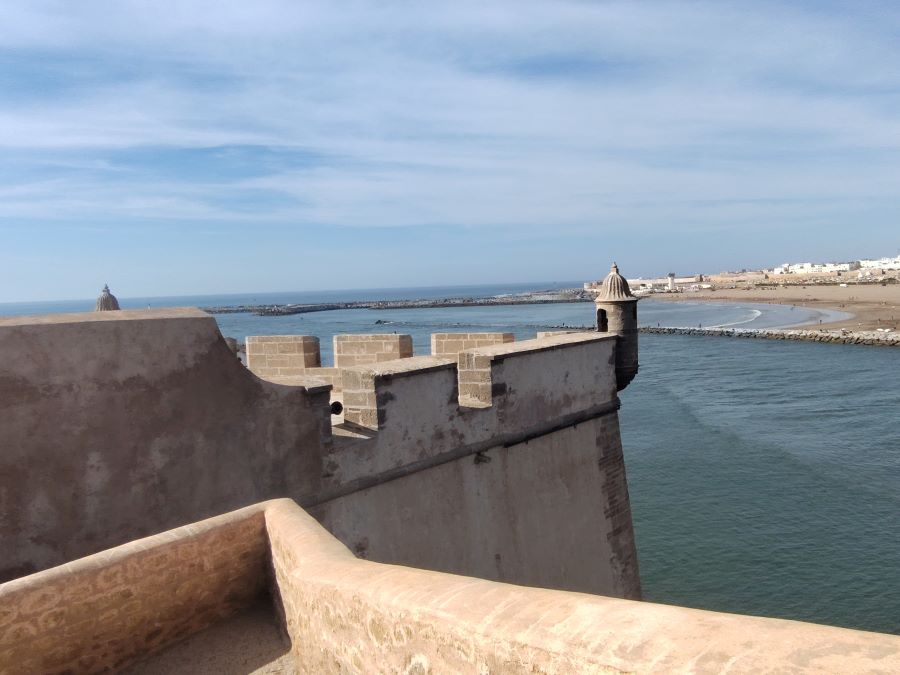
6. Terrace Overlooking the Bou Regreg River and Salé
- Panoramic views of the river, ocean, and city of Salé across the water
- A popular spot for sunset watching and photography
- Views of the marina and Rabat’s modern skyline in the distance

7. Skala (Old Gun Platform and Fortifications)
- Clifftop cannon platform used historically for defense
- Stone ramparts with views over the Atlantic Ocean
- Atmospheric spot with remnants of military history
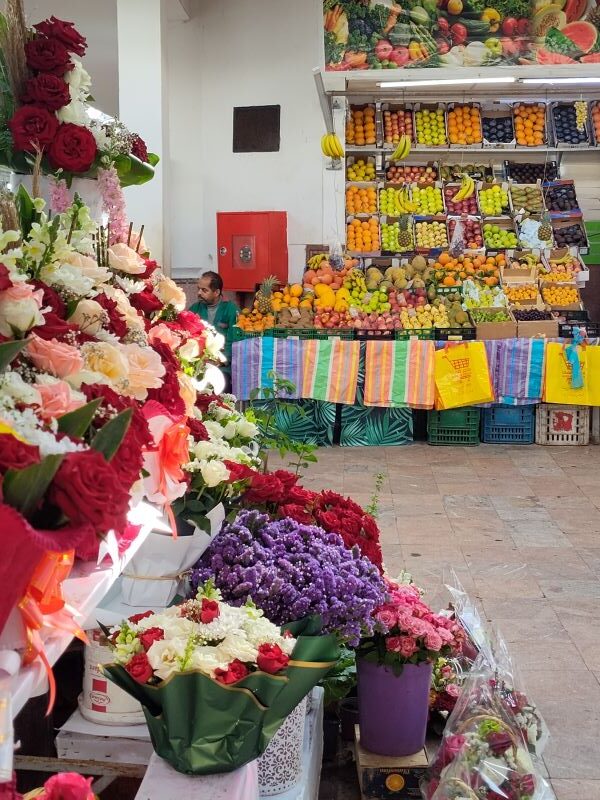
8. Local Artisan Stalls and Cafés
- Small shops selling traditional crafts and souvenirs
- Cozy tea houses and cafés with rooftop seating
- Ideal for people-watching or enjoying Moroccan mint tea
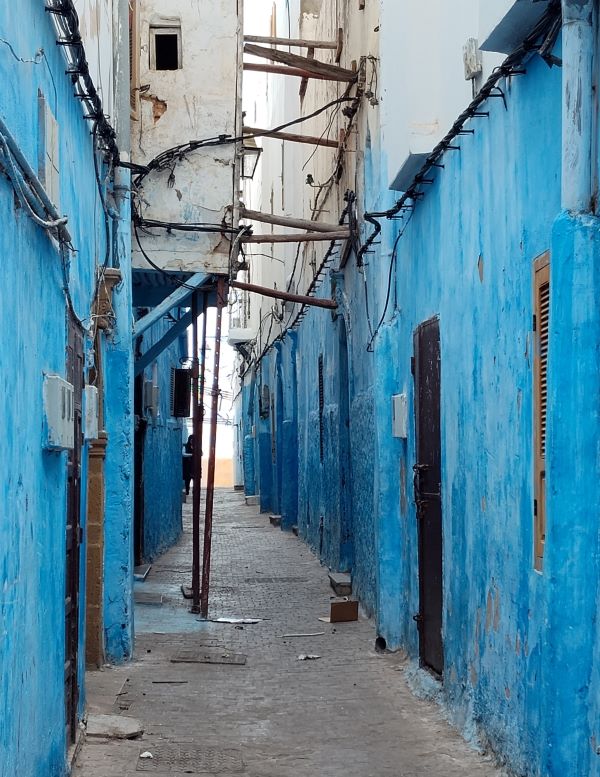
9. Blue and white section of the Kasbah of the Udayas
Not as famous as the blue city of Chefchaouen, the Kasbah of the Udayas has its own version of and old blue and white section or the actual village where the citizens lived safely within the confines of the Kasbah fortress. This section is still lived in by local families and show the daily life, markets and culture of this old section of the Kasbah and is not as touristy but still shows the reality of what life used to be like and still is living within the old city walls of the Kasbah. It’s fascinating exploring the area and I would definitely advise spending time exploring the area, visiting the markets and even trying out any of the local foods, specialty products and even trying out the fresh fruits for sale at the market stalls around the area.
The blue and white section of the Kasbah of the Udayas in Rabat is one of the most charming corners of the city, with narrow winding lanes, whitewashed walls, and vivid blue accents that reflect both Andalusian and Moroccan influences. This peaceful residential quarter, tucked within the ancient fortress walls, feels like stepping into a quiet village frozen in time. Bougainvillea spills over walls, cats lounge in the sun, and locals go about their day as visitors wander through this maze-like neighborhood. The blue tones, said to keep homes cool and ward off insects, add to the soothing atmosphere. It’s a picturesque spot that contrasts with the busy streets of modern Rabat, offering a slow, intimate look into the city’s historic roots.
It’s easy enough to explore the area and get lost, or you can use Google maps to show you the exit points around the section, marketplaces and how to get to the outside street areas.
Tip – The further you explore, the grittier if seems, but I felt safe and not bothered by any of the locals living in the area. I would advise to just take photos of the streets and avoid photographing people in general or just capture them at a distance.
Here’s a quick snapshot of exploring the area in details:
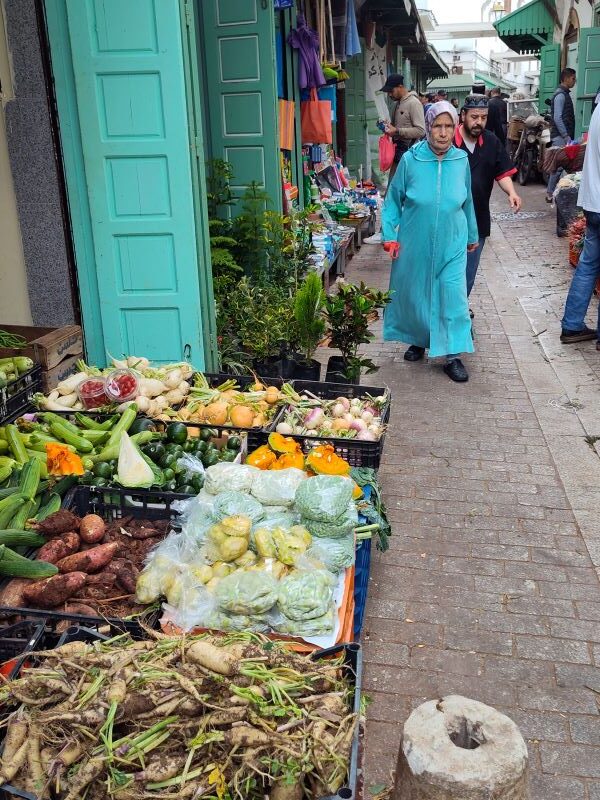
Walking the streets and market stalls around the Blue and White section of the Kasbah
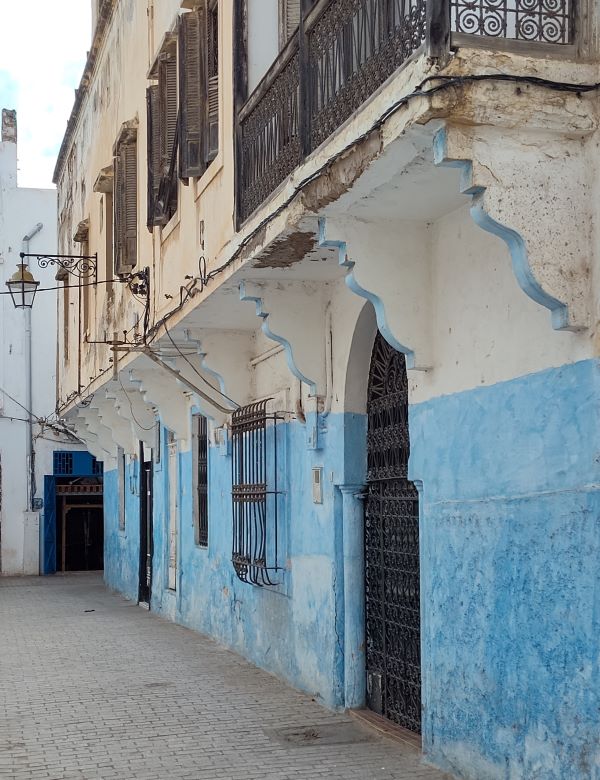
You can see daily life has almost remained unchanged from the beginning when the Kasbah was still a vital part of the city lifestyle and defense.
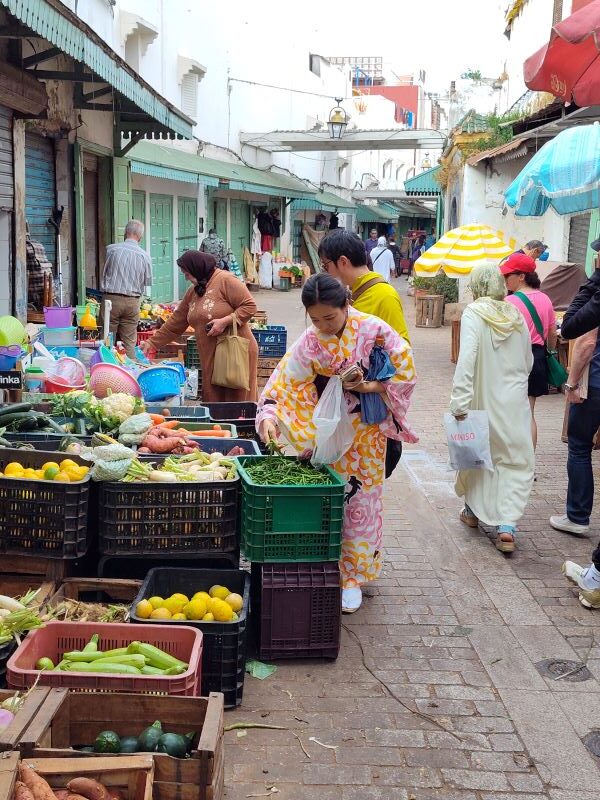
I found this fascinating that a visitor in a traditional Japanese garb was shopping along the streets of the Kasbah, but as you can see the fruits and vegetables sold here look very fresh and good quality.
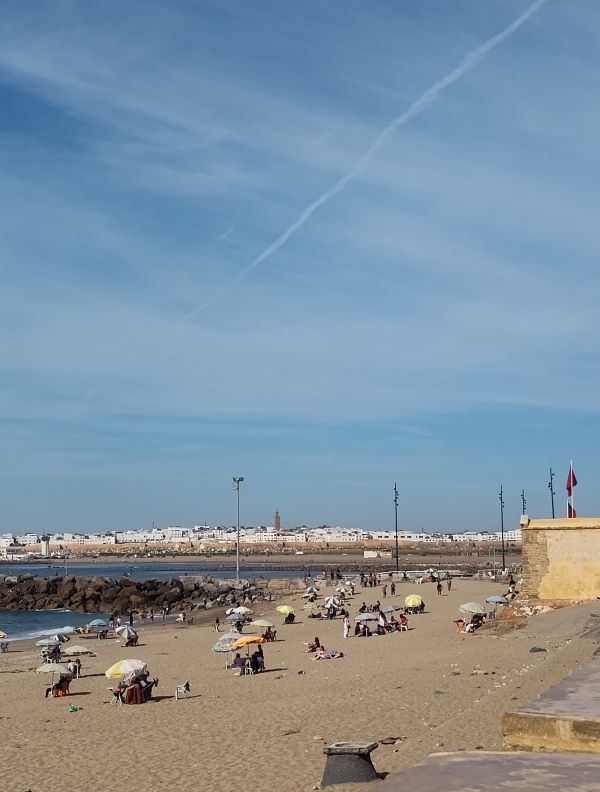
10. Beach areas of Rabat by the Kasbah
The beach areas near the Kasbah of the Udayas in Rabat offer a scenic and laid-back spot to unwind along the Atlantic. Just below the kasbah walls, you’ll find Plage de Rabat (also called Plage de l’Océan), a popular stretch of sand that draws locals and visitors alike for sunbathing, surfing, and evening strolls. To the north, the Bouregreg Marina marks the edge of the harbor area where the Bouregreg River meets the sea, offering cafes, boat docks, and views of neighboring Salé. The small beach nestled by the jetty near the marina is known as Plage de Salé Ville, and while it’s on the Salé side, it’s easily accessible by foot or tram from Rabat. The contrast between the historic kasbah walls and the crashing waves below gives this part of the city a relaxed but lively coastal vibe.
If you are looking for some easy beach time, you’ll find plenty of space to spread out and hang out with locals that frequent the beach areas, it’s a great place to swim, lounge, people watch and even have a picnic with things you can pick up from the local markets in the area.
Here’s some more detailed pictures below
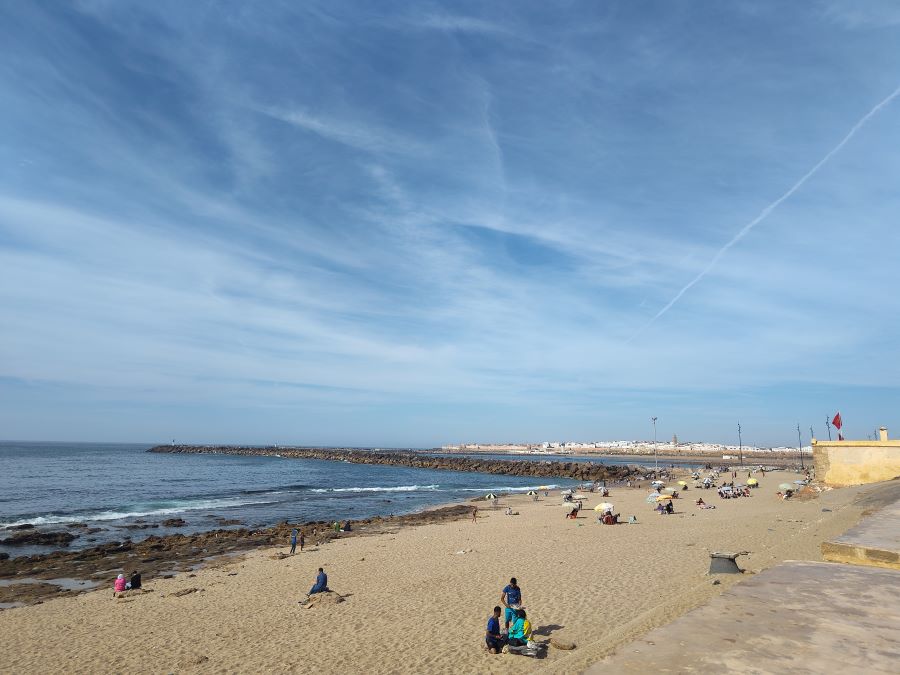
Beach area located below the fortifications of the Kasbah of the Udayas. If you’re up to it, you can even rent a surfboard or windsurfer to enjoy some active adventure on the ocean area fronting the beach.

Check out this video tour of the Kasbah of the Udayas below for a fun tour of this fortress and palace in Rabat
Further Reading; Exploring more of Morocco
Check out my posts visiting the Northern Regions of Morocco for more inspiration and images to exploring the area.
Things to do in Rabat, Morocco

About author – Noel Morata
After relocating from the United States to Andalusia in 2024, I’ve made it my mission to discover every corner of Spain along with many Mediterranean locations, cities and attractions. Based just east of Granada, I’ve spent a lot of time visiting Morocco including multiple extended visits to Marrakesh, Tangier, Chefchaoen and different parts of the country throughout different seasons. My background in history cultural studies and years of residence and exploring all of the Mediterranean countries have given me unique insight into the region’s historical significance, local customs, and culinary traditions.
I regularly update my guides with the latest information gathered through personal visits and relationships with local tourism officials, always seeking what’s new and exciting in each destination. As a self-proclaimed foodie, I’m passionate about discovering authentic local markets and regional specialties.
If you love antiquities and Unesco World Heritage sites, you should visit the Kasbah of the Udayas here in Rabat, Northern Morocco
Disclosure – some of the links above to various tours, transportation and hotels are affiliate links that benefits our site if you book here and we appreciate your support. The links are competitive, and you are not paying above what other affiliates provide.
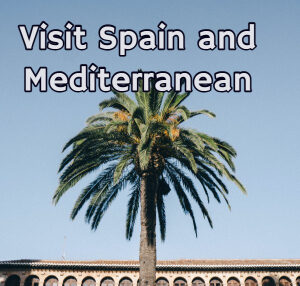
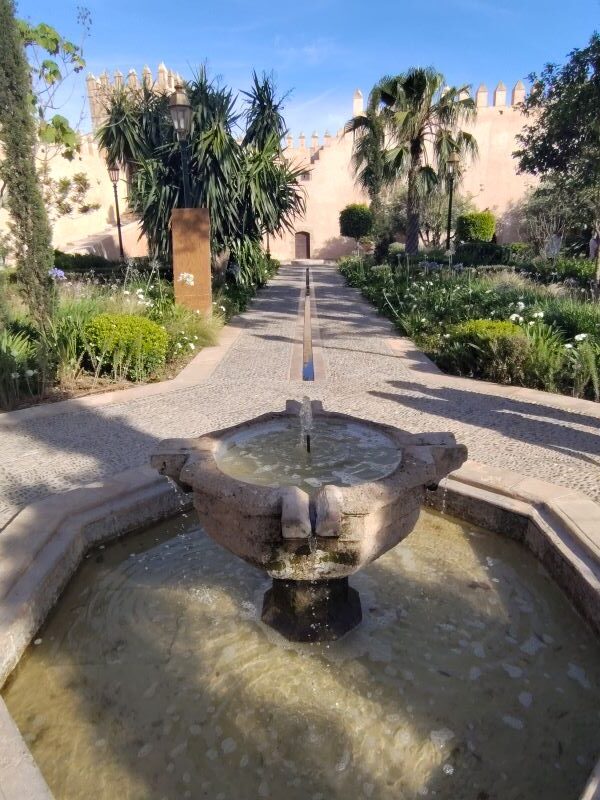
Great content , thanks for all the detailed information . I’m very excited to make the journey and use this as a guide for my trip. Thanks.
Thank you for your comment, it is a wonderful historic place worth visiting the Kasbah at Udayas here in Rabat, hope you get to visit soon!
This is a great website to learn about Spain and all it has to offer. The food looks phenomenal. Noel has done an outstanding job on providing wonderful & colorful details.
Thanks for the fantastic comments Kathy, I really appreciate it, hope you enjoyed this post on visiting the Kasbah of the Udayas in Rabat